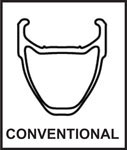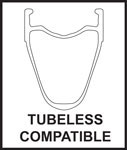

The Cause of Tight-Fitting Tires
by John Neugent
Tech articles | Commentary articles
The late John Neugent probably knew more about bicycle wheels than anyone else. Maybe more about bikes as well. He spent his life in the bike business, at every level. He owned Neugent Cycling, a firm devoted to delivering world-class equipment at the lowest possible price. —Chairman Bill

John Neugent

Les Woodland's book Cycling's 50 Triumphs and Tragedies: The rise and fall of bicycle racing's champions is available in print, Kindle eBook & audiobook versions. To get your copy, just click on the Amazon link on the right.
John Neugent writes:
I’ve written on this before but I still get lots of questions about it. Ever since tubeless compatible rims became pretty common many people have realized that it’s harder to mount tires. There are two main causes.
The first is there is no industry standard for sizing rims and tires that really affects their fit. The industry has been working on it for a number of years but Covid delayed a lot of those decisions that required lots of people in different companies interacting.


The images above show two rim profiles. One is conventional and one is tubeless compatible. When tubeless rims and tires were first introduced, a well-known maker of sealant for them told everyone his sealant would work with non-tubeless rims and tires. He soon backed off on that because people were blowing tires off rims – a very nasty event if it’s on the front wheel. But for quite some time many people used tubeless clincher tires with conventional rims with good luck. Somewhere along the line, and it wasn’t on my bike, people started blowing tubeless compatible clincher tires off of conventional rims.
Look at the two profiles and you will note that the tubeless compatible rim has “shoulders” for the bead. These do two things. They allow the bead to slide up and firmly seat itself with a much more positive fit than a conventional rim will allow. So much so that is normally a pain to get them to seat the first time and it can be even more of a pain to remove them. I’ve had tires that I literally had to put in a vice to unseat the bead. Conventional tires use a tube and it functions as a stop gap when the tire punctures. The tube is large enough to keep the tire on the rim even if it’s flat (almost always).
One very common misunderstanding is that it’s the size of the rim wall that makes tires hard to mount. This is not true. It’s the depth of the channel in the rim that allows the beads the space needed to easily mount a tire (or not). For that reason it’s essential to make sure your beads are in the center section while mounting the tire. Why not make the channel deeper on all rims? Because the tires would be more likely to fall off the rim when it gets a flat.
All of these issues are magnified because there are no standards and almost every quality tire uses an Aramid or Kevlar bead which stretch, and it’s all too common to get tires with varying bead dimensions even amongst the same brand and model.
John Neugent was was one of the first to establish quality hand building in Taiwan around the turn of the century. He now owns Neugent Cycling, a firm devoted to delivering world-class equipment at the lowest possible price.







